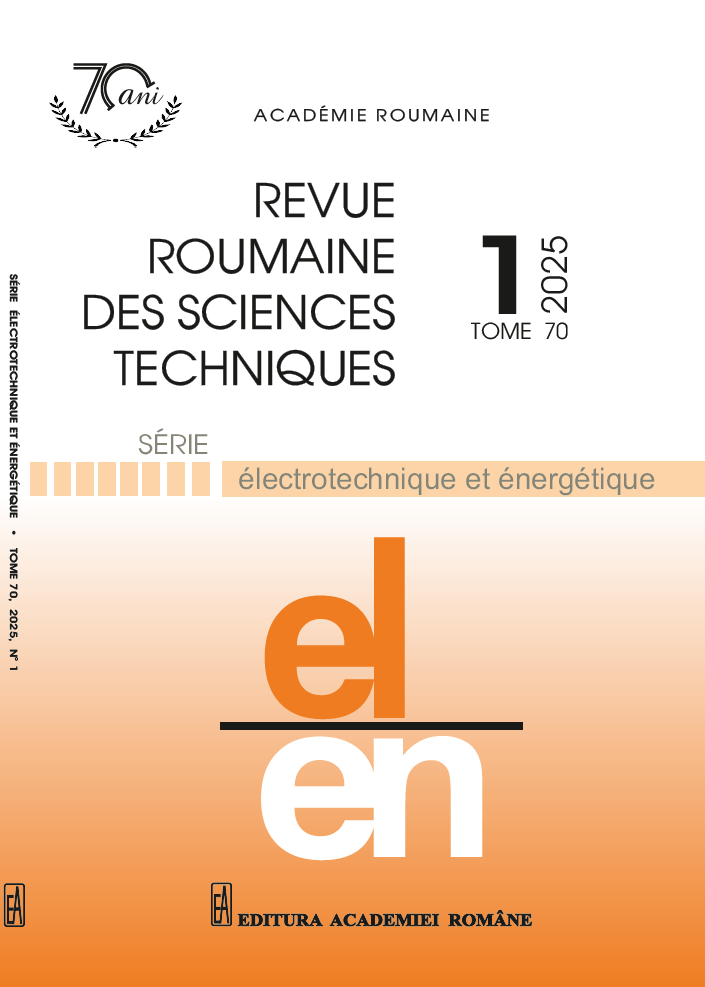MESURES EXPÉRIMENTALES IMPACT DE LA FRÉQUENCE DE COMMUTATION DU SIGNAL DE COMMANDE DU MOSFET SUR LES INTERFÉRENCES ÉLECTROMAGNÉTIQUES DANS UN HACHEUR SÉRIE
DOI :
https://doi.org/10.59277/RRST-EE.2025.1.12Mots-clés :
Fréquence de commutation, Interférence électromagnétique, Hacheur série, Mode différentiel, Mode communRésumé
Les convertisseurs statiques sont constitués de commutateurs électroniques, de composants passifs (inductance, condensateur) et de résistances, permettant la conversion de l'énergie électrique. Cependant, l'utilisation de composants semi-conducteurs (MOSFET, IGBT, thyristor, etc.) en commutation génère des variations rapides de tension (dv/dt) et de courant (di/dt). Ceci conduit à des perturbations électromagnétiques haute fréquence. Cet article présente l'étude des perturbations électromagnétiques conduites en modes commun et différentiel dans un hacheur série par simulation à l'aide du logiciel LTspice. Des mesures expérimentales valident les résultats obtenus. Nous avons ensuite étudié l'impact de la variation de la fréquence de commutation sur le courant d'entrée et la tension de sortie du hacheur, ainsi que sur les perturbations conduites en deux modes, mode commun et différentiel, par des mesures expérimentales dans les domaines temporel et fréquentiel. Un programme Arduino effectue ces variations sur les paramètres du signal de commande.
Références
(1) A.G. Aulagnier, M.C. Cousineau, T.M. Meynard, E. Rolland, K. Abouda, High frequency EMC impact of switching to improve DC-DC converter performances, European Conference on Power Electronics and Applications, pp. 1–9 (2013).
(2) K. Muttaqui, M. Haque, Electromagnetic interference generated from fast switching power electronic devices, International Journal of Innovations in Energy Systems and Power, 3, 1, pp. 19–45 (2018).
(3) A.A. Ales, A. Gouichiche, Z. Karouche, B. Moussaoui, D. Sachen, J.L. Roudet, The accurate input impedances of a DC/DC converters connected to the network, IEEE International Conference on Environment and Electrical Engineering, pp. 1–6 (2005).
(4) H. Slimani, A. Zeghoudi, A. Bendaoud, A. Reguig, B. Benazza, N. Benhadda, Experimental measurement of conducted emissions generated by static converters in common and differential modes, European Journal of Electrical Engineering (EJEE), 23, 3, pp. 273–279 (2021).
(5) A. Zeghoudi, A. Bendaoud, H. Slimani, B. Benazza, J. Bennouna, Determination of electromagnetic disturbances in a buck chopper, Australian Journal of Electrical and Electronics Engineering (2022).
(6) A. Zeghoudi, H. Slimani, A. Bendaoud, A. Benazza, S. Bechekir, H. Miloudi, Measurement and analysis of common and differential modes conducted emissions generated by an AC/DC converter, Electrical Engineering & Electromechanics, 1, pp. 3–9 (2022).
(7) B. Benazza, A. Bendaoud, J.L. Schanen, Etude exprimentale sur l’impact des emissions CEM du au positionement d’un convertisseur statique DC-DC entre une source et une charge, Colloque International et Exposition sur la Compatibilite Electromagnetique (CEM), pp. 1–6 (2018).
(8) A. Zeghoudi, A. Bendaoud, H. Slimani, H. Miloudi, M. Miloudi, N. Chikhi, Experimental measurement of common and differential modes for variable speed drive DC motor, IEEE Multiconference on Signal, Systems, Devices, Setif, Algeria (2022).
(9) O. Laudatu, D. Niculae, M.I. Iordache, M.-L. Bobaru, M. Stanculescu, Experimental analysis of power semiconductor elements used in flyback converters, Rev. Roum. Sci. Techn.– Électrotechn. et Énerg., 69, 1, pp. 67–72 (2024).
(10) A.A. Saafan, V. Khadkikar, M.S.E. Moursi, H.H. Zeineldin, A new multiport DC-DC converter for DC microgrid applications, IEEE Transactions on Industry Applications, 59, 1, pp. 601–611 (2023).
(11) S. Latreche, B. Babes, A. Bouafassa, Design and real-time implementation of synergetic regulator for a DC-DC boost converter, Rev. Roum. Sci. Techn.– Électrotechn. et Énerg., 69, 3, pp. 305–310 (2024).
(12) B. Khvitia, A. Gheonjian, Z. Kutchadze, R. Jobava, A SPICE model for IGBTs and power MOSFETs focusing on EMI/EMC in high-voltage systems, Electronics, 10, pp. 2822 (2021).
(13) L. Han, L. Liang, Y. Wang, X. Tang, S. Bai, Performance limits of high voltage press-pack SiC IGBT and SiC MOSFET devices, Power Electronic Devices and Components, 3, 100019 (2022).
Téléchargements
Publiée
Numéro
Rubrique
Licence
(c) Copyright REVUE ROUMAINE DES SCIENCES TECHNIQUES — SÉRIE ÉLECTROTECHNIQUE ET ÉNERGÉTIQUE 2025

Ce travail est disponible sous licence Creative Commons Attribution - Pas d'Utilisation Commerciale - Pas de Modification 4.0 International.


